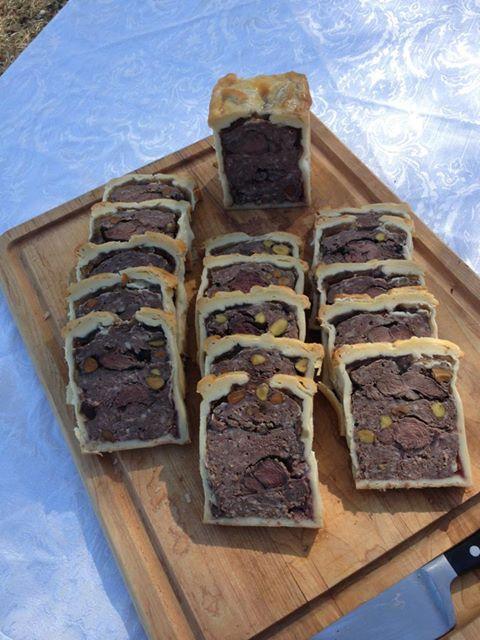
longroper
participating member-
Posts
37 -
Joined
-
Last visited
Recent Profile Visitors
1,426 profile views
-
I do them (professionally) at 155 for about an hour, then into a frying pan or hot oven to crisp the casing. The advantage of the oven over the pan is that the whole casing gets brown and not just the part touching the pan. You can pull them before an hour, but they'll take a little longer in the pan to finish cooking through. If you need to hold them, they hold at 137 for basically forever. They'll shed a little fat, but not enough to matter.
-
Mayonnaise made with duck fat is awesome. To go along with the OP's fish tendencies, I've used duck fat mayo as a binder in fish cakes. It gives them a deep savory note that people love but cannot pinpoint.
-
It makes lovely savory biscuits. Interesting in a warm vinaigrette as well.
-
We read plenty of criticisms about all the general things that restaurants do that displease people. What do restaurants do that make you happy?
-
It doesn't really look like a medium steak. It's a firm texture, though not dry at all, red all the way through due to the cure. The texture is something like lightly cooked dry-cured bacon, which is more or less what it is. I served some of it crisped a bit in the pan on sandwiches and again, it wasn't dry or overcooked or falling apart.
-
Did a corned brisket last week 138F for 48 hours. I smoked it lightly first, not long enough to raise the temp. Came out beautiful. Lots of raves.
-
Yeah, this. I missed the part in the OP mentioning the pressure cooker. You still have to clarify it to make consomme, but the point of doing it in the pressure cooker (aside from speed) is that there's no boiling and hence little opportunity for fat to emulsify. You can't make a consomme out of emulsified stock. I've tried.
-
Consommé. Aspic. Glace de viande. Chaudfroid. The first two assume a very-carefully-attended-to stock. The latter two not so much. Head cheese. Scrapple.
-
a principal difference between finance and the restaurant business is that no one has to buy, deliver, store, and prepare highly perishable goods in finance. opening the door of a restaurant for a day costs time and money that you may not recoup. opening on a day you are ordinarily not open on costs even more time and even more money, particularly since most people are not on salary and could easily be running into overtime. a restaurant is part service business, part factory. flexibility in a factory is more expensive than flexibility in a pure service operation. there are any number of reasons why a particular restaurant is not open on a particular day, but in the case of any place anywhere that's been reasonably successful for any length of time, they are not likely to be that the restaurant is not attempting to maximize its profit. but maximizing profit and maximizing the number of customers you serve are not the same thing.
-
never used the kitchen aid, but the most important thing is to cut the meat so that it easily fits down the throat of the grinder, and to feed only as fast as the machine can handle, or slower. let one bit be ground before dropping the next. long strips are best as they wrap around the worm and self-feed at the correct pace. if you're feeding at the proper speed, you should never have to use the tamper. the slower you feed, the faster you can grind.
-
I stole my technique from Cook's Illustrated. Raw salmon, finely diced. Bound with fresh bread and a little mayonnaise. Grated onion, salt, pepper, whatever spices blow your skirt up. Form into patties- the mixture will be very soft and sticky - and put them on a sheet pan. Stick it into the freezer for fifteen or twenty minutes- however long it takes for the patties to firm up a little. You still have to handle them gently when you flour, egg, and panko them. They don't really hold together well until they're fried. The idea is that the fish proteins provide most of the structure as they cook. I do this with every kind of fish, and they take very well to the treatment.
-
I have one of these: http://www.thermos.com/products/gourmet-coffee-press.aspx Works very well. Insulated. I get about three large mugs out of it, and the last is close to as hot as the first. My wife got it for me; I don't know from where.
-
It reminds me of very rich beef. There is little marbling but quite a bit of fat on the outside of the meat. It is deep red. I get it from a friend who traps in the winter. I typically cook the backstrap hot, fast, and rare and braise the hind quarter. I have smoked it before the braise as well. This really opened my eyes to the possibilities of game pâtés. You avoid the textural problems you can sometimes run into with game, smooth the flavor (which for some people can be too intense), and turn it into a ready-to-eat form that can serve considerably more people than many other methods of cooking. And people think it's cool.
-
Thank you. I've had it at 425 for the first 20 minutes or so. I'll try it for longer. Do you have overcooking issues cooking it so hot, or does the crust keep the temperature inside it more moderate?
-
Beaver pate en croute: The pastry was not one of my best; I think the flour was old and I had to add too much water to make it workable. Also, my only pate mold is a nonstick, and I've never gotten the sides to brown as well as I feel they should, in both a commercial and a home oven. Would an ordinary tinned steel mold make a difference?



